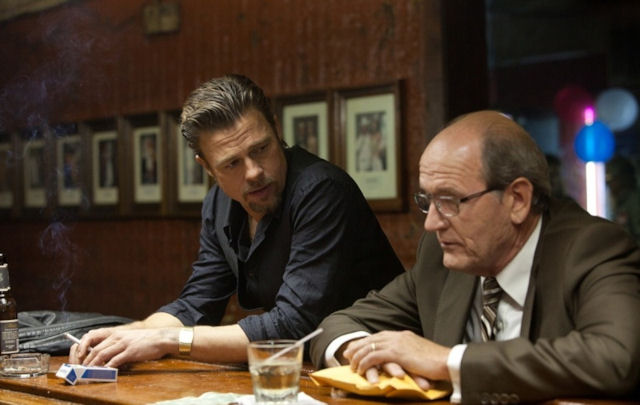Culture
Making a “Killing” in America

Killing Them Softly
dir. Andrew Dominik
Release Date: Nov 30, 12
- 1
- 2
- 3
- 4
- 5
- 6
- 7
- 8
- 9
- 10
Andrew Dominik’s last film, The Assassination of Jesse James by the Coward Robert Ford, used a lyrical, dreamy approach to the western, leading ultimately to a film that wasn’t so much a revisionist approach to that genre (as many have said), but instead a film within its own universe, a place where the emotions are simultaneously muted and broad, where the violence is every bit as sadistic as it is in this one, but unfolds at a tenth of the speed. Likewise, Killing Them Softly takes this approach to the modern crime drama, moving the action from George Higgins’ novel Cogan’s Trade from Boston to flood-abused New Orleans in order to drive home the sparse situation of the film’s many desperate men, and to set the stage for the film’s even bigger purpose to reveal itself.
Jackie Cogan (Brad Pitt, oily and excellent) is a hitman, but also an enforcer of sorts, hired by various criminals as much for his moral flexibility as for his ability to immediately perceive all the angles. He’s weary of this work, but he’s good at it, and he makes a mint doing what men like the bosses of Richard Jenkins’ nameless driver can’t and won’t. After Frankie (Scoot McNairy, in a performance that makes one wonder if Casey Affleck just wasn’t available) and the feral-looking Russell (Ben Mendelsohn) rob a protected card game at the behest of “The Squirrel” (Vincent Curatola), Jackie is sent to hunt down the trio, as well as Marky (Ray Liotta), the host of the robbed game with a previous history of sticking up his own events. Seeking help, Jackie calls for Mickey (James Gandolfini) to assist him, but Mickey turns out to prefer drinking to excess and sleeping his way across town.
Dominik ably captures the exhaustion running through the film’s whole criminal underworld. Frankie might be a fool, but he’s not unaware that somebody like Jackie is headed his way. Jackie, for his part, knows that the organization for which Jenkins works is a fair bit cowardly, sending somebody else to do their work from afar. (He prefers this as well, in his own way: “I like to kill ‘em softly, from a distance. I don’t like getting touchy-feely.”) But everybody’s trying to make money, and everybody has a role to play. Some of these roles are particularly sadistic; a pair of rain-soaked bursts of violence serve as minute operas of carnage, and the film’s final monologue, while much less bloody, is equally despairing in its view of how America now functions. At times this carnage feels undercut by the film’s deliberate pacing, but to cut it down any further would not only put it under the 90-minute mark, but attempt to reduce Killing Them Softly to an easy kind of violent catharsis in which Dominik seemingly isn’t all that interested.
The film operates on a far grander level than its depicted events, and if the best reason to see Killing Them Softly is also its most notable drawback, then so it goes. The film is set against a major American backdrop, not just in its New Orleans setting but also in its time period. (To even tell you in what year the film takes place would give away the whole thing.) News clips buoy the point, and for what’s otherwise a carefully crafted piece of filmmaking, in those moments the film often steps away entirely from its story to drive home its central thesis with the subtlety of a sledgehammer. Simultaneously, there’s a painful beauty to the idea at the film’s core that everybody is alone now, and that optimism is a thing of the past. While Killing Them Softly is both fatalistic about this and just a little too willing to use hindsight like a crystal ball, it’s still eerily close to the truth. In Dominik’s version of America, you’re on your own.